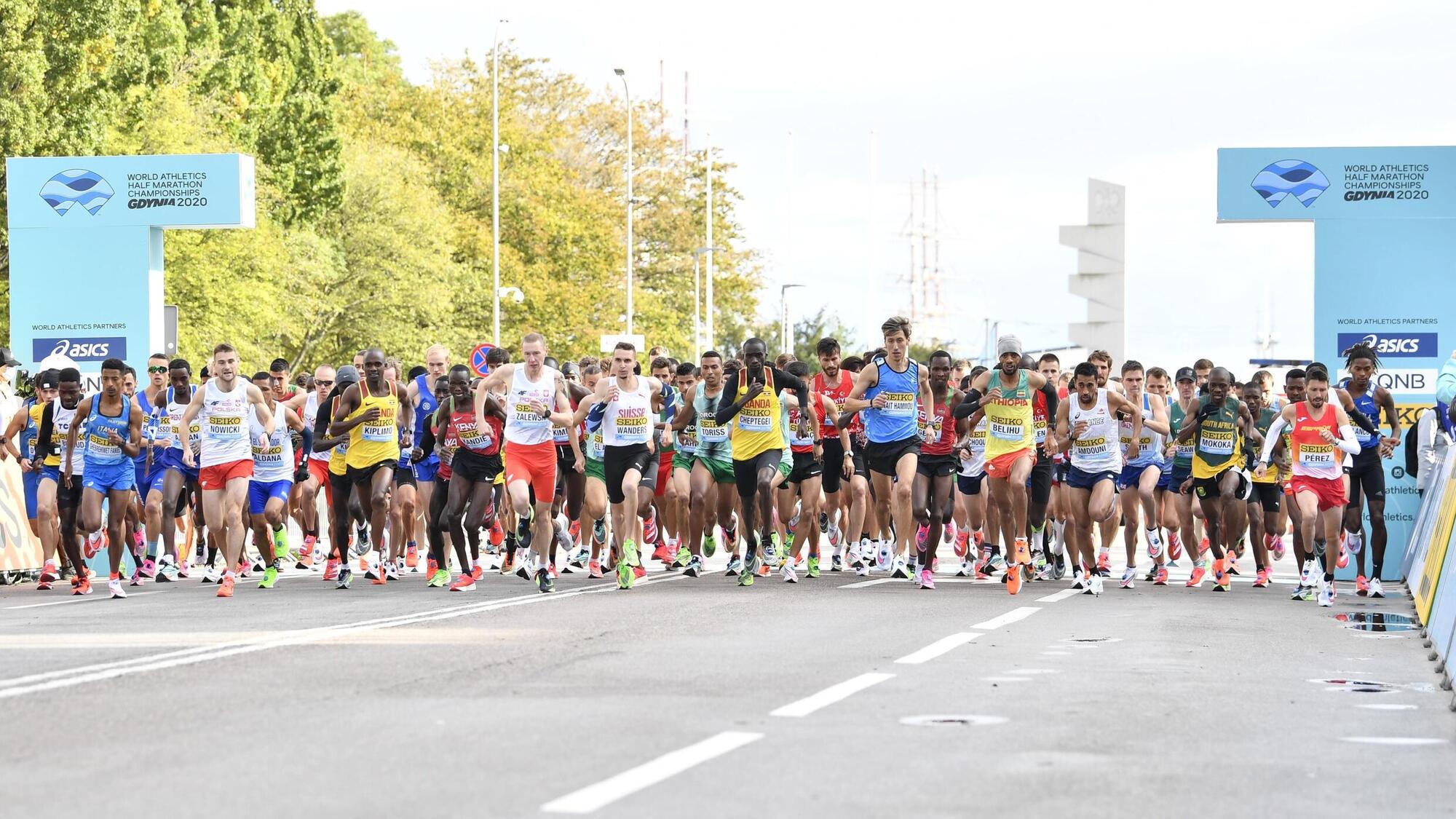

Featured
How To Sign Up For A Half Marathon
Modified: January 2, 2024
Learn how to sign up for a featured half marathon and take your running goals to the next level. Join us today and conquer the distance!
Introduction
Signing up for a half marathon is a challenging and rewarding endeavor that can push you to new limits both physically and mentally. Whether you’re a seasoned runner looking for a new goal or a beginner ready to take on a new fitness challenge, participating in a half marathon can be a life-changing experience.
A half marathon is a race that covers a distance of 13.1 miles or 21.1 kilometers. It’s a popular choice for many runners as it provides a significant challenge without the intensity of a full marathon. However, don’t be fooled by the name; completing a half marathon still requires months of training and dedication.
There are several key steps involved in signing up for a half marathon, from choosing the right event to preparing for the big day. This guide will walk you through the process, ensuring you’re well-equipped to tackle the journey ahead.
In the following sections, we’ll cover each step in detail, providing you with all the information you need to successfully sign up for and complete a half marathon. So, let’s lace up our shoes and dive into this exciting adventure!
Step 1: Research and Choose a Half Marathon
The first step in signing up for a half marathon is to research and choose the event that suits your goals and preferences. With numerous races taking place around the world, it’s essential to find one that aligns with your interests and fits into your schedule.
When researching half marathons, consider factors such as location, course terrain, date, and reputation. Do you prefer a scenic route or a challenging hill-filled course? Would you like to run in a big city or a more relaxed setting? Take your time to explore different options and read reviews from past participants to get an idea of what to expect.
Additionally, consider your fitness level and the time you have available for training. If you’re a beginner, you may want to choose a race that allows ample training time. On the other hand, if you’re an experienced runner looking to push your limits, you might opt for a more competitive event.
Popular half marathons such as the New York City Half Marathon, the Rock ‘n’ Roll Half Marathon Series, and the Great North Run offer well-organized races with a lively atmosphere. However, there are also numerous local and smaller-scale events that can provide an equally rewarding experience.
Once you’ve narrowed down your options, visit the race’s official website and carefully review the event details. Make note of important information such as registration fees, deadlines, and any requirements or restrictions. Familiarize yourself with the race rules and regulations to ensure you’re fully prepared.
It’s also worth considering the charity affiliations of the race. Many half marathons partner with charitable organizations, allowing participants to raise funds for a good cause while accomplishing their own personal goals. If supporting a particular charity is important to you, seek out events that have charity affiliations.
Remember, signing up for a half marathon is not a decision to be taken lightly. It’s a commitment that requires time, effort, and dedication. So take the time to research and choose an event that resonates with you, as it will greatly enhance your overall half marathon experience.
Step 2: Check the Requirements and Eligibility
Once you have selected a half marathon to participate in, it’s important to check the requirements and eligibility criteria set by the race organizers. Each event may have different rules and guidelines that you need to meet in order to sign up and participate.
Start by reviewing the minimum age requirement for the race. Some half marathons have an age restriction, while others may offer separate categories for different age groups. Make sure you meet the age criteria before proceeding with the registration process.
In addition to age, certain half marathons may have qualification standards. These standards are typically based on finishing times from previous races, and they are put in place to ensure a certain level of fitness and running ability. If there are qualification criteria, assess whether you meet or can reasonably achieve the required benchmarks.
Furthermore, be aware of the registration deadlines. Many popular half marathons have limited spots available and may fill up quickly. It’s important to register early to secure your spot and avoid disappointment. Keep track of the opening and closing dates for registration, and make sure you complete the process within the specified timeframe.
Another crucial aspect to consider is the registration fee. Most half marathons require participants to pay a registration fee, which covers the cost of organizing the event. The fee can vary depending on factors such as location, race size, and amenities provided. Ensure that you are aware of the amount and payment methods accepted to complete your registration successfully.
As part of the requirements, some races may also ask for medical information or proof of physical ability. This can include a recent doctor’s certificate or a specific medical form to be filled out. It’s important to understand the medical requirements and ensure you are in good health to participate in the half marathon.
Lastly, familiarize yourself with the race policies, including rules related to transfers, deferrals, and refunds. Life circumstances can change, and it’s important to know your options if you need to modify or cancel your registration.
By checking the requirements and eligibility criteria, you can ensure that you meet all necessary conditions to participate in the half marathon of your choice. This step will help you avoid any last-minute surprises and ensure a smooth and hassle-free registration process.
Step 3: Create a Training Plan
Creating a training plan is an essential step in preparing for a half marathon. It helps you gradually build your fitness level, improves your endurance, and minimizes the risk of injuries. With a well-structured training plan, you’ll be better equipped to tackle the challenges of the race.
Begin by assessing your current fitness level. Evaluate your running experience, average weekly mileage, and overall endurance. This self-assessment will serve as a starting point for designing a training plan that suits your individual needs.
Next, determine the duration of your training period. Half marathon training typically takes between 12 and 16 weeks, but the exact length may depend on your current fitness level and running experience. Allow ample time to gradually increase your training load and adapt to the demands of longer distances.
When designing your training plan, consider the principle of progressive overload. This means gradually and systematically increasing the intensity, duration, and frequency of your runs over time. Begin with shorter, easier runs and gradually build up to longer distances and more challenging workouts.
Include a combination of running workouts in your training plan. This can include long runs to build endurance, tempo runs to improve speed, interval training to enhance cardiovascular fitness, and recovery runs to allow for rest and recovery. Varying the types of runs you do will help you develop different aspects of your running ability and keep your training interesting.
In addition to running, incorporate cross-training activities into your plan. Cross-training, such as strength training, cycling, or swimming, can help improve overall fitness, prevent muscle imbalances, and reduce the risk of overuse injuries. Aim to cross-train 1-2 days a week to supplement your running workouts.
Remember to include rest days in your training plan. Rest and recovery are just as important as the actual training. They allow your body to repair and adapt, reducing the risk of injury and improving performance. Listen to your body and take rest days as needed.
Throughout your training, be mindful of your nutrition and hydration. Fuel your body with balanced meals, focusing on quality carbohydrates, lean proteins, and healthy fats. Stay hydrated by drinking enough water throughout the day, especially before, during, and after your runs.
Lastly, track your progress and make adjustments to your training plan as necessary. Monitor your mileage, pace, and how you feel during and after workouts. If you’re consistently struggling or experiencing pain, it may be a sign to modify your plan or seek guidance from a professional coach or trainer.
By creating a well-rounded and structured training plan, you’ll be on your way to preparing effectively for the half marathon. Remember to be consistent, stay motivated, and listen to your body throughout the training process.
Step 4: Get the Right Gear and Equipment
Having the right gear and equipment is essential when preparing for a half marathon. The proper gear can enhance your comfort, support your performance, and help prevent injuries. Here are some key considerations when selecting your gear:
1. Running Shoes: Invest in a pair of high-quality running shoes that provide proper cushioning and support. Visit a specialty running store to get fitted for shoes that match your foot type and running style. Break them in gradually during your training to avoid discomfort on race day.
2. Moisture-Wicking Clothing: Choose moisture-wicking clothing that allows your skin to breathe and keeps you dry during your runs. Opt for lightweight, breathable fabrics that prevent chafing and irritation. Consider the weather conditions in which you will be running and dress accordingly.
3. Performance Socks: Invest in moisture-wicking, cushioned socks that reduce the risk of blisters. Look for socks specifically designed for running that provide support and comfort to your feet. Avoid cotton socks as they tend to retain moisture and can promote blisters.
4. GPS Watch or Running App: Consider using a GPS watch or a running app on your smartphone to track your distance, pace, and other metrics during your training runs. This can help you monitor your progress and ensure you’re staying on target with your training goals.
5. Hydration Gear: For longer training runs and the actual half marathon, you’ll need a reliable hydration system. This can be a handheld water bottle, a hydration belt, or a hydration backpack. Find a system that works best for you and practice using it during your training.
6. Body Glide or Anti-chafing Products: Apply body glide or anti-chafing products to areas where friction may occur, such as between your thighs, underarms, or wherever you have experienced chafing in the past. This will help prevent discomfort and skin irritation during your runs.
7. Running Belt or Armband: A running belt or armband can be useful for carrying essentials such as your phone, ID, keys, and energy gels during your training runs. Find one that fits comfortably and securely while allowing easy access to your belongings.
8. Sunglasses and Sunscreen: Protect yourself from the sun’s harmful rays by wearing sunglasses with UV protection and applying sunscreen to exposed skin. Look for lightweight and sweat-resistant sunscreen to ensure it stays on during your runs.
When selecting your gear, it’s important to try items on and test them during your training runs. This will give you an opportunity to make any necessary adjustments or changes before the actual race.
Remember, investing in the right gear and equipment will not only enhance your performance but also contribute to your overall comfort and enjoyment during the half marathon. Be prepared and well-equipped for a successful race day experience.
Step 5: Start Training
Now that you have your half marathon training plan in place and the right gear and equipment, it’s time to start your training. This step is where your hard work and dedication will truly pay off as you begin to build your endurance and strengthen your running abilities.
Follow your training plan consistently and aim to complete each run as scheduled. Start with shorter distances and gradually increase the duration and intensity of your runs over time. This progressive approach will help prevent overexertion and reduce the risk of injuries.
Consistency is key in training for a half marathon. Stick to your designated training days, even when motivation is low. Establishing a routine will make it easier to stay on track and develop the necessary habits for success.
Focus on building endurance through your long runs. These runs are essential for preparing your body for the 13.1-mile distance. Gradually increase the distance of your long runs each week until you reach the target distance specified in your training plan.
Include speed workouts in your training regimen to improve your overall pace and increase your cardiovascular fitness. These can consist of tempo runs, intervals, and hill repeats. These workouts help you develop speed, endurance, and mental strength to maintain a challenging pace throughout the race.
Don’t neglect rest and recovery days. They are just as important as the training runs themselves. Rest days allow your body to repair and adapt, helping to prevent overuse injuries and optimize performance. Use rest days for light cross-training or active recovery activities such as stretching or yoga.
Listen to your body and pay attention to any aches, pains, or signs of fatigue. If necessary, adjust your training plan to accommodate rest or recovery days. Ignoring these warning signs can increase the risk of injury and hinder your progress.
As you progress through your training, take note of any improvements or milestones you achieve. It could be running a new personal best in a shorter distance or completing a long run at your goal pace. Celebrating these accomplishments will help boost your confidence and keep you motivated.
Stay disciplined and committed to your training even when faced with challenges or setbacks. Running a half marathon requires mental toughness as well as physical fitness. Push through the tough moments knowing that these are the times when you’re building your resilience.
Lastly, don’t be too hard on yourself if you miss a training run or your performance doesn’t meet your expectations. Maintain a positive mindset and remember that consistency, perseverance, and patience are key to achieving your half marathon goal.
By following your training plan and staying committed, you’ll be well-prepared physically and mentally for the half marathon. Embrace the journey, stay focused, and trust in your training. The race day will be within reach before you know it.
Step 6: Sign up for the Half Marathon
After weeks or months of training, it’s time to make it official and sign up for the half marathon. This step is an exciting milestone that solidifies your commitment and sets the stage for your race day experience.
First, go to the official website of the half marathon in which you have chosen to participate. Look for the registration section and carefully read through all the information provided. Take note of the registration dates, fees, and any required documentation or waivers.
Check if there are any discounts available, such as early bird registration or group rates. Taking advantage of these offers can help save you money on the registration fee. Set reminders for the registration opening date to ensure you secure your spot in the race.
Fill out the registration form accurately and provide any necessary information. This may include your personal details, emergency contact information, estimated finish time, and any medical conditions or allergies you have. Be honest and transparent in your responses to ensure race organizers have the essential information they need.
Verify the registration details before proceeding to the payment section. Double-check all the information you have provided to ensure it is correct. Errors or discrepancies in your registration details can cause issues on race day or during the packet pickup process.
Choose your preferred payment method and complete the transaction. Most half marathons accept various payment options such as credit cards or online payment platforms. Ensure that the process is secure and that you receive a confirmation email or receipt for your registration.
Some races offer optional add-ons, such as race merchandise or pre- and post-race activities. Consider whether these extras align with your preferences and budget. Keep in mind that some items may be limited in availability, so make your selections promptly if interested.
Once you have successfully registered, mark the race date on your calendar and make note of any important deadlines or race-related information provided by the organizers. Prepare to receive further communication or race updates via email or through the race’s official website.
Keep in mind that some races have limited spots available, and they can fill up quickly. It’s important to register as early as possible to secure your spot. Waiting until the last minute might result in disappointment if the race reaches its capacity.
Congratulations! You are now officially signed up for the half marathon. Take a moment to celebrate this milestone in your journey, acknowledging your commitment and hard work. The next step is to continue your training and focus on your race day preparation – you’re one step closer to crossing that finish line!
Step 7: Prepare for Race Day
Race day is approaching, and it’s time to prepare for the big event. The following steps will ensure that you’re ready physically, mentally, and logistically for the half marathon:
1. Taper Your Training: As you approach race day, gradually reduce the intensity and volume of your training. This tapering period allows your body to recover and restore energy for optimal performance on race day. Trust in your training and resist the temptation to overdo it in the final days.
2. Create a Race Day Plan: Familiarize yourself with the race logistics, start time, and location. Plan your transportation and parking, taking into account any road closures or detours. Ensure you have all the necessary items ready, including your bib number, timing chip, and any required identification.
3. Review the Course: Study the race route and elevation profile. Identify any challenging sections or key landmarks along the way. Mentally prepare yourself for what to expect during the race, and visualize crossing that finish line with strength and determination.
4. Stay Hydrated and Nourished: Pay attention to your hydration and nutrition leading up to the race. Drink plenty of water and consume a balanced diet with carbohydrates for energy. Avoid trying new foods or supplements on race day to prevent any digestive issues or discomfort.
5. Get Sufficient Rest: Prioritize sleep and aim for at least 7-8 hours of quality sleep each night leading up to the race. Allow your body to recover and recharge, ensuring that you wake up on race day feeling refreshed and energized.
6. Prepare Your Race Day Gear: Lay out your race day outfit, including your running shoes, socks, clothing layers, and any accessories you plan to wear. Make sure everything is clean, comfortable, and ready to go. Check the weather forecast and dress accordingly.
7. Plan Your Race Day Nutrition: Determine your pre-race meal that is easily digestible and provides the necessary energy. Eat your meal at least 2-3 hours before the race to allow enough time for digestion. Avoid heavy, greasy foods that may cause stomach discomfort during the race.
8. Visualize Success: Spend time visualizing yourself running strong, crossing the finish line, and achieving your goals. Positive visualization can help reduce pre-race nerves and enhance your mental preparedness.
9. Stay Positive and Manage Your Nerves: It’s natural to feel a mix of excitement and nerves leading up to race day. Acknowledge your emotions and find ways to manage any anxiety. Surround yourself with supportive people, listen to motivational music, or practice deep breathing exercises to stay calm.
10. Review Race Etiquette: Familiarize yourself with race etiquette and rules, including starting corral procedures, passing etiquette, and race etiquette. Respect fellow runners and be mindful of the race officials and volunteers who make the event possible.
By following these steps to prepare for race day, you’ll be setting yourself up for a successful and enjoyable half marathon experience. Stay focused, trust your training, and believe in your abilities. You’re ready to conquer those 13.1 miles!
Step 8: Complete the Half Marathon
It’s finally here – race day! After weeks of training and preparation, it’s time to lace up your running shoes and tackle the challenge of completing the half marathon. Here’s what you need to do to ensure a successful and fulfilling race day experience:
1. Arrive Early: Plan to arrive at the race venue with plenty of time to spare. This will give you ample time to find parking, use the restroom, and warm up. Avoid the stress of rushing by allowing extra time in your schedule.
2. Warm Up Properly: Begin your race day with a dynamic warm-up routine to get your muscles primed and ready for the run. Incorporate light jogging, dynamic stretches, and mobility exercises to increase blood flow and improve flexibility.
3. Stick to Your Race Plan: During the race, maintain a pace that aligns with your race plan and training goals. Avoid getting caught up in the excitement and starting too fast. Maintain a steady pace and focus on running your own race.
4. Stay Hydrated and Fuel Smart: Make use of the hydration stations along the race route to stay properly hydrated. Consume energy gels or sports drinks as needed to replenish electrolytes and maintain energy levels during the run. Listen to your body’s signals and adjust your fluid and fuel intake accordingly.
5. Maintain Mental Resilience: Running a half marathon can be physically and mentally challenging, especially as fatigue sets in. Embrace any discomfort or fatigue as a normal part of the race. Stay positive, mentally engaged, and use various mental strategies such as positive self-talk or focusing on short-term goals to stay motivated.
6. Enjoy the Experience: Take time to immerse yourself in the race atmosphere and enjoy the journey. Appreciate the cheering spectators, fellow runners, and the scenic views along the route. Smile, high-five spectators, and draw energy from the positive energy surrounding you.
7. Listen to Your Body: Pay attention to any signs of fatigue, pain, or discomfort during the race. If you feel a potential injury coming on or are experiencing significant discomfort, it’s important to prioritize your well-being. Slow down, walk, or seek medical attention at one of the race first aid stations if necessary.
8. Finish Strong: As you approach the final stretch, summon your remaining energy and push through the fatigue. Dig deep and give it your all as you cross the finish line. The sense of accomplishment and the joy of completing the half marathon will be worth every step.
9. Rehydrate and Refuel: After completing the race, make sure to rehydrate with water or electrolyte-rich fluids. Eat a balanced post-race meal that includes carbohydrates, proteins, and healthy fats to aid in recovery and replenish energy stores. Allow your body time to rest and recover in the days following the race.
10. Celebrate Your Achievement: Be proud of what you have accomplished. Take time to celebrate your successful completion of the half marathon. Share your experience with friends, family, and fellow runners. Reflect on the journey, the lessons learned, and the personal growth that came from it.
Completing a half marathon is a significant achievement that demonstrates your determination, commitment, and perseverance. Embrace the challenge, enjoy the experience, and relish in the satisfaction of crossing that finish line. You did it!
Conclusion
Congratulations on completing your journey to sign up for and complete a half marathon! You’ve embarked on a challenging and rewarding adventure that has pushed you to new limits, both physically and mentally. By following the steps in this guide, you have set yourself up for success and ensured a memorable and fulfilling race day experience.
Throughout the process, you have researched and chosen a half marathon that aligns with your goals and preferences. You have checked the requirements and eligibility criteria, created a training plan, acquired the right gear and equipment, and started your training with dedication and consistency. You have successfully signed up for the race and prepared yourself physically and mentally for the ultimate challenge. And finally, you have completed the half marathon with strength and determination.
Remember, the journey to a half marathon is not just about the race day itself. It’s about the personal growth, self-discipline, and resilience that you have developed along the way. Cherish the memories of the countless training runs, the support from fellow runners, and the sense of accomplishment as you crossed that finish line.
Take the lessons learned from this experience and apply them to future endeavors. Running a half marathon has provided you with a solid foundation for setting and achieving goals in various aspects of your life. Continue to challenge yourself and strive for greatness in all that you do.
Lastly, be proud of what you have accomplished. Completing a half marathon is an incredible achievement that not everyone can claim. Remember the dedication, determination, and commitment it took to accomplish this goal. Carry that sense of accomplishment with you, knowing that you are capable of achieving anything you set your mind to.
Now, take a moment to celebrate your achievement, rest, and recover. Be grateful for the experience, the lessons learned, and the memories made. Whether this was your first half marathon or one of many, the journey you have embarked upon will leave a lasting impact on your life.
Thank you for joining us on this journey to sign up for and complete a half marathon. We hope this guide has provided you with the necessary knowledge and inspiration to take on and conquer future challenges. Lace up your shoes, set new goals, and continue to explore the incredible world of running!









